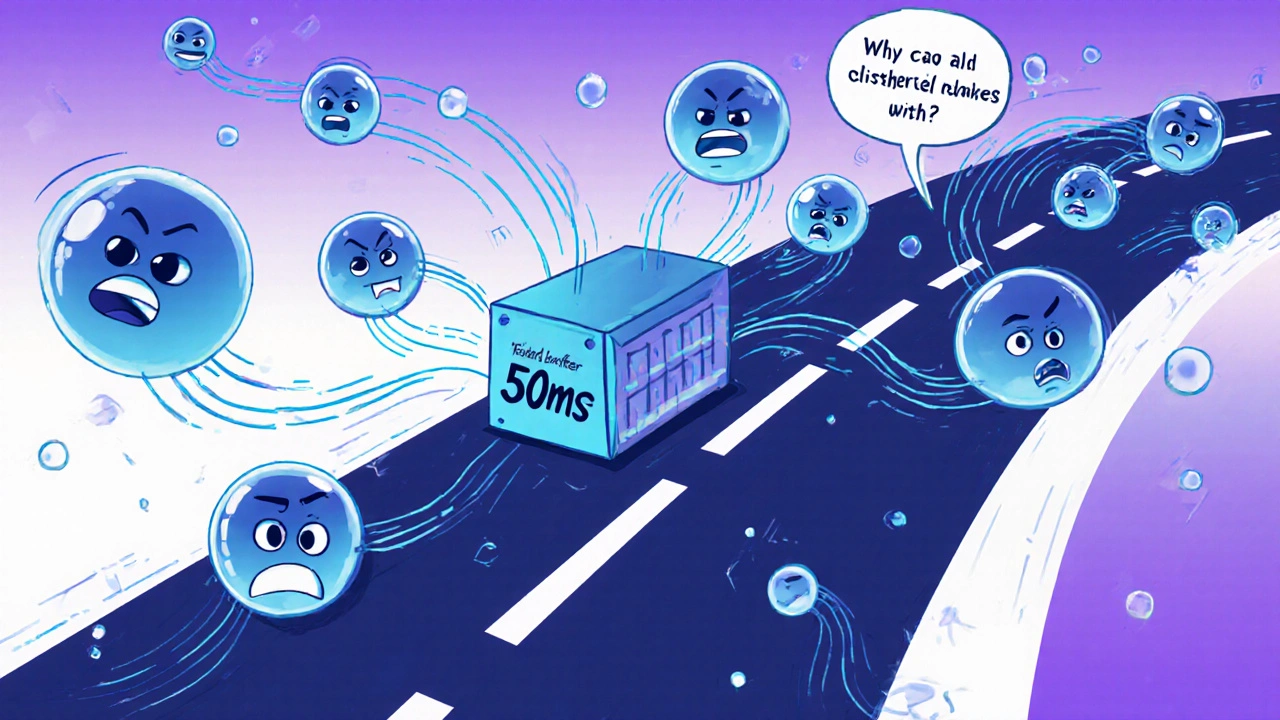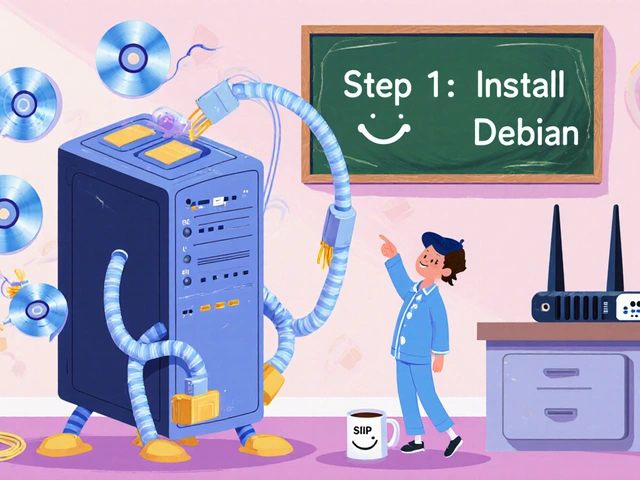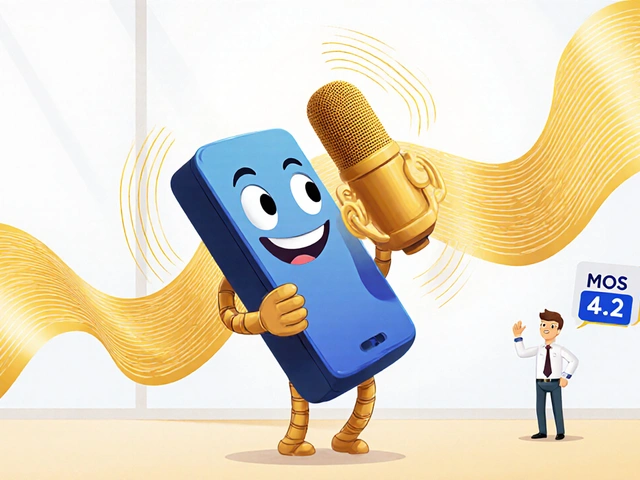Ever been on a VoIP call where the person on the other end sounds like they’re talking through a broken speaker? Choppy audio, sudden pauses, or voices cutting out - it’s not your internet being slow. It’s your jitter buffer doing the wrong thing.
Every VoIP call relies on jitter buffers to smooth out the chaos of internet packet delivery. But not all jitter buffers are created equal. Some stay fixed at one size, no matter what. Others change on the fly. Choosing between a dynamic jitter buffer and a fixed jitter buffer can make or break your call quality - especially if you’re working from home, running a call center, or managing a remote team.
What Exactly Is a Jitter Buffer?
VoIP calls break your voice into tiny digital packets. These packets race across the internet, but they don’t all arrive at the same time. Some come early. Some are late. Some get lost. This variation in arrival time is called jitter.
A jitter buffer is like a holding area. It waits a few milliseconds before playing back the audio, giving late packets time to show up. Then it stitches everything together into smooth, natural-sounding speech.
Without a jitter buffer, you’d hear robotic glitches every time network traffic slowed down - which happens all the time, especially on home Wi-Fi or mobile data.
Modern jitter buffers are built into VoIP phones, softphones like Zoom or Microsoft Teams, and even routers. The best ones today, like Chromium’s NetEQ, use smart algorithms to decide exactly how long to wait - and when to let packets go.
Fixed Jitter Buffer: Simple, But Rigid
A fixed jitter buffer uses the same delay for the entire call. You set it once - say, 50ms or 100ms - and it never changes.
This approach is simple. Easy to configure. Low processing power needed. That’s why it was the standard in early VoIP systems.
But here’s the problem: networks don’t stay still.
If your network suddenly gets jittery - say, someone starts streaming video or your Wi-Fi gets crowded - a fixed 50ms buffer can’t adapt. Packets that arrive after 70ms? They get dropped. You hear gaps. Audio cuts out.
On the flip side, if you set the buffer too high - say, 150ms - your calls feel sluggish. People talk over each other. It’s like a bad Zoom call with a 2-second delay. Conversation becomes awkward.
Fixed buffers work fine in controlled environments: corporate offices with dedicated QoS (Quality of Service) settings, low-traffic networks, or when every device is wired. But if your users are on mobile, working from coffee shops, or using home internet, fixed buffers start to fail.
According to VoIP Troubleshooter (2023), fixed buffers reduce audio issues by 70-90% - but only if network jitter stays under 30ms. Outside that range? Performance plummets.
Dynamic Jitter Buffer: Smarter, Adaptive, Self-Healing
A dynamic jitter buffer - also called an adaptive jitter buffer - watches the network in real time. It measures how much jitter is happening right now, and adjusts its buffer size accordingly.
When the network is calm, it shrinks the buffer to 30ms. Less delay. More natural conversation.
When traffic spikes - say, during a Zoom meeting with 10 people on the same Wi-Fi - it expands to 180ms. It holds packets longer, waiting for the latecomers. No drops. No gaps.
This isn’t magic. It’s math. Algorithms track packet arrival times, calculate jitter trends, and decide whether to hold or release. Some, like NetEQ, even analyze the audio signal itself to predict what’s missing and fill in gaps intelligently.
Studies show dynamic buffers reduce packet loss by 35-60% compared to fixed ones during unstable conditions. Enterprise users who switched from fixed to dynamic buffers reported 30% fewer complaints about choppy audio.
Big platforms like Zoom, Microsoft Teams, and Google Meet all use dynamic buffers. Why? Because they have to. Their users are everywhere - on 4G, home routers, public Wi-Fi. Fixed buffers would make their service unusable.
And it’s not just consumer apps. According to Wainhouse Research’s 2023 Unified Communications Market Report, 97% of consumer video conferencing tools now use adaptive jitter buffers. Even enterprise VoIP systems are moving fast - 82% now rely on dynamic buffers.

When to Use a Fixed Jitter Buffer
Before you write off fixed buffers entirely, here’s when they still make sense:
- You’re in a controlled enterprise environment with managed QoS, dedicated circuits, and wired connections.
- Your network consistently shows jitter below 20-30ms.
- You need ultra-low latency - think call centers where every millisecond counts.
- You’re deploying legacy hardware that can’t handle the processing load of adaptive algorithms.
Network consultant David Coleman points out that in these cases, fixed buffers actually deliver more consistent results. Why? Because adaptive buffers can sometimes overreact. A brief network hiccup might trigger a buffer expansion, causing a noticeable pause - which users hate more than a quick glitch.
Fixed buffers don’t surprise you. They’re predictable. And in the right setting, that’s a feature, not a bug.
When to Use a Dynamic Jitter Buffer
Dynamic buffers are the default choice for almost everyone else:
- Your team works remotely or on mobile devices.
- You’re using Wi-Fi, cellular data, or shared internet connections.
- You’re running a call center with mixed network environments.
- You’ve had complaints about choppy audio, dropped words, or unnatural pauses.
- You’re using modern VoIP platforms like RingCentral, 8x8, or Cisco Webex.
Dynamic buffers handle real-world chaos. They don’t need manual tuning. They adapt automatically. And with AI-driven versions now in use - like the neural network-based packet loss concealment in WebRTC 1.0.26231.0 - they’re getting smarter every year.
Edge computing is making them even better. Instead of sending audio to a central server to process, edge-deployed buffers adjust locally. That cuts effective jitter by up to 45%, according to Klearcom (2023).
And the numbers back it up: G2 reviews show solutions with dynamic buffers average 4.6/5 for call quality, compared to 4.2/5 for fixed ones. The top reason? “Smooth audio even on unstable connections.”
Real-World Trade-Offs
There’s no perfect solution. Every choice has a cost.
Fixed buffers: low latency, high risk. If jitter spikes, you get audio dropouts. No recovery. No second chances.
Dynamic buffers: higher average latency, but far fewer dropouts. You might add 20-50ms of delay on average - but you’ll rarely hear a gap.
ITU-T G.114 recommends one-way delays stay under 150ms for high-quality voice. Dynamic buffers can push close to that limit during heavy jitter - but they’re designed to stay just under it. Fixed buffers? They might stay at 50ms, but if jitter hits 80ms, you’re losing packets anyway.
And here’s a hidden cost: configuration. Setting up a fixed buffer requires hours of network monitoring to find the sweet spot. Dynamic buffers? You install them, and they learn on their own.

What’s Next for Jitter Buffers?
The future isn’t just adaptive - it’s predictive.
Cisco’s 2024 roadmap includes buffers that anticipate network changes based on time of day, user location, and historical traffic patterns. Imagine your buffer knowing your Wi-Fi gets congested every evening at 6 p.m. - and getting ready before it happens.
Gartner predicts that by 2025, 90% of enterprise platforms will use self-optimizing jitter buffers. That’s up from 65% in 2023.
Even 5G isn’t a magic fix. Ericsson’s 2023 tests show that dynamic buffers still struggle with sub-10ms latency requirements for AR/VR voice applications. So innovation continues.
But for now? If you’re choosing between fixed and dynamic - and you’re not in a perfectly controlled network - go dynamic. Every time.
How to Decide for Your Setup
Ask yourself these questions:
- Do most of your users work from home or on mobile?
- Have you received complaints about choppy audio in the last 30 days?
- Is your network managed with QoS, or is it shared consumer internet?
- Are you using modern VoIP software (Zoom, Teams, RingCentral)?
If you answered “yes” to any of the first three - you need a dynamic jitter buffer.
If you answered “yes” only to the last one, and your network is wired, stable, and monitored - you might be fine with fixed. But even then, dynamic is safer.
Bottom line: If you’re not using a dynamic jitter buffer, you’re leaving call quality to chance. And in today’s remote-first world, that’s not a risk worth taking.
What causes jitter in VoIP calls?
Jitter happens when voice packets arrive at uneven times due to network congestion, Wi-Fi interference, or routing changes. It’s not slow internet - it’s inconsistent delivery. Even on a fast connection, packets can take different paths and arrive milliseconds apart, causing audio distortion.
Can jitter buffers fix lost packets?
No. Jitter buffers only handle delayed packets. If a packet is lost completely - dropped by a router or never sent - the buffer can’t recover it. That’s why advanced buffers use packet loss concealment (PLC) to guess what the missing audio should sound like based on surrounding speech patterns.
How much delay do jitter buffers add to calls?
Well-tuned jitter buffers add between 20ms and 200ms of delay. Dynamic buffers average 40-80ms, while fixed ones might stay at 50ms or 100ms. Anything over 150ms starts to feel laggy in conversation. ITU-T G.114 recommends keeping total one-way delay under 150ms for clear voice quality.
Do I need to configure a dynamic jitter buffer manually?
Usually not. Dynamic buffers auto-adjust based on real-time network data. But for best results, you can fine-tune sensitivity settings - like how aggressively the buffer expands or contracts. This takes about 1-2 hours of testing per deployment, usually handled by IT teams using network monitoring tools.
Why do some people say dynamic buffers cause unnatural pauses?
Sometimes, when jitter spikes suddenly, a dynamic buffer expands quickly to hold more packets. If the network clears up right after, the buffer stays large for a moment, creating a short delay before playback resumes. This can feel like a pause or echo. Modern algorithms minimize this, but older or poorly tuned implementations can cause it. That’s why vendor quality matters - Cisco and Zoom have far better implementations than budget VoIP providers.
Which is better for remote workers: fixed or dynamic?
Dynamic, without question. Remote workers use unpredictable networks - home Wi-Fi, public hotspots, mobile data. A fixed buffer set for 50ms will drop packets when jitter hits 70ms. A dynamic buffer expands to handle it. In one enterprise case, switching to dynamic buffers cut remote user complaints by 30%.
Is jitter buffer technology improving?
Yes. The latest versions, like WebRTC’s NetEQ, now use machine learning to predict network behavior and reconstruct lost audio. Edge computing lets buffers act closer to the user, cutting delay. By 2025, most enterprise systems will use self-learning buffers that adjust based on time-of-day patterns and historical traffic - not just real-time jitter.
Final Recommendation
If you’re choosing a VoIP system today - or upgrading your existing one - look for dynamic jitter buffers. Don’t just assume it’s there. Ask your vendor: “Do you use adaptive jitter buffering? What algorithm do you use?”
Zoom, Microsoft Teams, RingCentral, and Cisco Webex all use advanced dynamic buffers. If your provider doesn’t mention it, that’s a red flag.
For most businesses and remote workers, the benefits of fewer dropouts, smoother audio, and zero manual tuning far outweigh the tiny increase in average delay. The future of VoIP isn’t about faster internet. It’s about smarter buffering.









Tyler Durden
5 Nov 2025 at 01:33Man, I’ve been on calls where it felt like the person was talking through a tin can with a fan blowing on it-turns out, my jitter buffer was stuck on 50ms like it was 2012. Switched to dynamic last month, and holy crap, it’s like my home office finally got a brain. No more ‘you’re cutting out’ nonsense. Even my dog stopped barking at the speaker during Zoom calls. Seriously, if you’re still using fixed, you’re not being lazy-you’re being cruel to your coworkers.